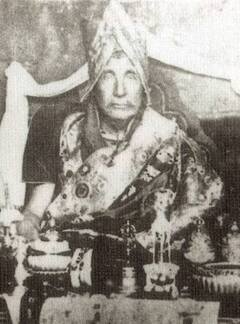Dampa Rinpoche Swift Rebirth Prayer
༄༅། །མཆོག་སྤྲུལ་མྱུར་འབྱོན་གསོལ་འདེབས་བཀྲ་ཤིས་ཟླ་སྣང་ཞེས་བྱ་བ་བཞུགས་སོ། །
The Moonlight of Auspiciousness
Prayer for the Swift Return of the Supreme Tulku
by Jamyang Khyentse Chökyi Lodrö
ཨོཾ་སྭསྟི།
om swasti
Oṃ svasti!
ངག༵་ལ་དབ༵༵ང་བསྒྱུར་འཇམ་མགོན་དགྱེས་པའི་གཏེར། །
ngak la wanggyur jamgön gyepé ter
Master of speech, treasure delighting Mañjunātha,
མདོ་སྔགས་བློ༵་གྲོས༵༵་རྒྱ་མཚོའི་མཛོད་འཆང་བ། །
do ngak lodrö gyatsö dzö changwa
Bearer of oceanic insights into sūtra and mantra,
གཞན༵་ལ་ཕན༵་པའི་མཛད་ཕྲིན་ཕ་མཐའ་ཡས། །
zhen la penpé dzetrin pata yé
Whose activity to benefit others is unbounded—
དཔལ་ལྡན་བླ་མའི་ཞབས་ལ་གསོལ་བ་འདེབས། །
palden lamé zhab la solwa deb
Glorious guru, at your feet I pray.
གང་ཁྱོད་ཆོས་ཀྱི་དབྱིངས་སུ་སྙོམས་ཞུགས་ཀྱང་། །
gang khyö chö kyi ying su nyom zhuk kyang
Although you have entered the ultimate dharma-sphere,1
བསྟན་འགྲོར་རྗེས་ཆགས་ཐུགས་རྗེས་མི་འདོར་ཞིང་། །
ten dror jé chak tukjé mi dor zhing
Do not give up your compassionate concern for the teachings and beings,
བརྩེ་ཆེན་སྙིང༵་པོ༵འི་རིང་ལུགས་གསལ་བའི་ཕྱིར། །
tsé chen nyingpö ringluk salwé chir
But in order to illuminate the tradition of Tsechen [Kunga] Nyingpo,
སླར་ཡང་མཆོག་གི་སྤྲུལ་སྐུ་མྱུར་བཞེངས་གསོལ། །
lar yang chok gi tulku nyur zheng sol
Swiftly arise once again in supreme nirmāṇakāya form.
སྙིགས་མ་ལྔ་བདོའི་བསྟན་འགྲོའི་རྒུད་སེལ་ཞིང་། །
nyikma nga dö ten drö gü sel zhing
Banishing the ills of fivefold degeneration among teachings and beings,
རིགས་དང་བརྩེ་བ་ཤེས་རབ་ལང་ཚོ་རྒྱས། །
rik dang tsewa sherab langtso gyé
Blossoming with youthful intelligence, kindness and enlightened potential,
རྒྱལ་བ་དགྱེས་པའི་སྤྱོད་པ་ལེགས་གནས་པའི། །
gyalwa gyepé chöpa lek nepé
And abiding by the conduct that delights the victorious ones—
མཆོག་གི་སྤྲུལ་སྐུ་ཁྱད་འཕགས་སྣང་མཛད་གསོལ། །
chok gi tulku khyé pak nang dzé sol
May such a supreme and noble tulku shine forth, I pray.
དེ་ཡང་བར་ཆད་བདུད་ཀྱི་གཡུལ་ལས་རྒྱལ། །
deyang barché dü kyi yul lé gyal
Then may you may triumph in the battle with obstructive demons,
སྐུ་ཚེ་མི་ཤིགས་ཡུན་དུ་བརྟན་པ་དང་། །
kutsé mishik yündu tenpa dang
Live long with indestructible vitality,2
གསན་བསམ་སྒོམ་པའི་ཡོན་ཏན་མཐའ་ཡས་པར། །
sen sam gompé yönten tayepar
And acquire infinite qualities of learning, contemplation and meditation—
འབད་མེད་མངའ་དབང་འབྱོར་བའི་བཀྲ་ཤིས་ཤོག །
bemé nga wang jorwé tashi shok
May all be auspicious so that this may effortlessly come to pass.
ཅེས་པའང་རྗེ་བཙུན་ཨེ་ཝཾ་པ་ཆེན་པོའི་འདྲེན་མཆོག་ཆོས་ཀྱི་རྒྱལ་པོ་ཁང་གསར་མཁན་ཆེན་དམ་པ་རིན་པོ་ཆེ་ཞིང་ཁམས་སུ་གཤེགས་པ་ན། རྗེ་དེ་ཉིད་ཀྱི་རིགས་ཆོས་ཐུགས་ཀྱི་སྲས་གཅིག་མགོན་གཟིགས་ཞབས་དྲུང་རིན་པོ་ཆེའི་བཀའ་ལུང་གཙུག་ཏུ་མཆོད་དེ་འཇམ་དབྱངས་ཆོས་ཀྱི་བློ་གྲོས་པས་རྩེ་གཅིག་གུས་པས་གསོལ་བ་བཏབ་བཞིན་བྲིས་པ། །མཆོག་གི་སྤྲུལ་སྐུའི་ཟླ་སྣང་མྱུར་དུ་འཆར་བའི་རྒྱུར་འགྱུར་བ་བླ་མ་རྒྱལ་བ་སྲས་བཅས་ཀྱིས་བྱིན་གྱིས་བརླབས་ཏུ་གསོལ། སརྦ་དཱ་མངྒ་ལཾ།། །།
Thus, when the sovereign of Dharma and supreme guide [in the lineage] of the great Lord Evaṃpa, Khangsar Khenchen Dampa Rinpoche, departed for a pure realm, I, Jamyang Chökyi Lodrö, reverently took up the instruction of his own kinsman and heart-son, Gönzik Zhabdrung Rinpoche, and wrote this as I supplicated with single-pointed devotion.3 I pray that the gurus, victorious ones and their heirs may confer their blessings, so that this may become a cause for the swift emergence of the moonlight of a supreme nirmāṇakāya. Sarvadā maṅgalam.
| Translated by Adam Pearcey with the generous support of the Khyentse Foundation and Tertön Sogyal Trust, 2022.
Source:
'Jam dbyangs chos kyi blo gros. "mchog sprul myur 'byon gsol 'debs//" in 'Jam dbyangs chos kyi blo gros kyi gsung 'bum. 12 vols. Bir: Khyentse Labrang, 2012. (BDRC W1KG12986). Vol. 3: 459–460
Version: 1.0-20220324
